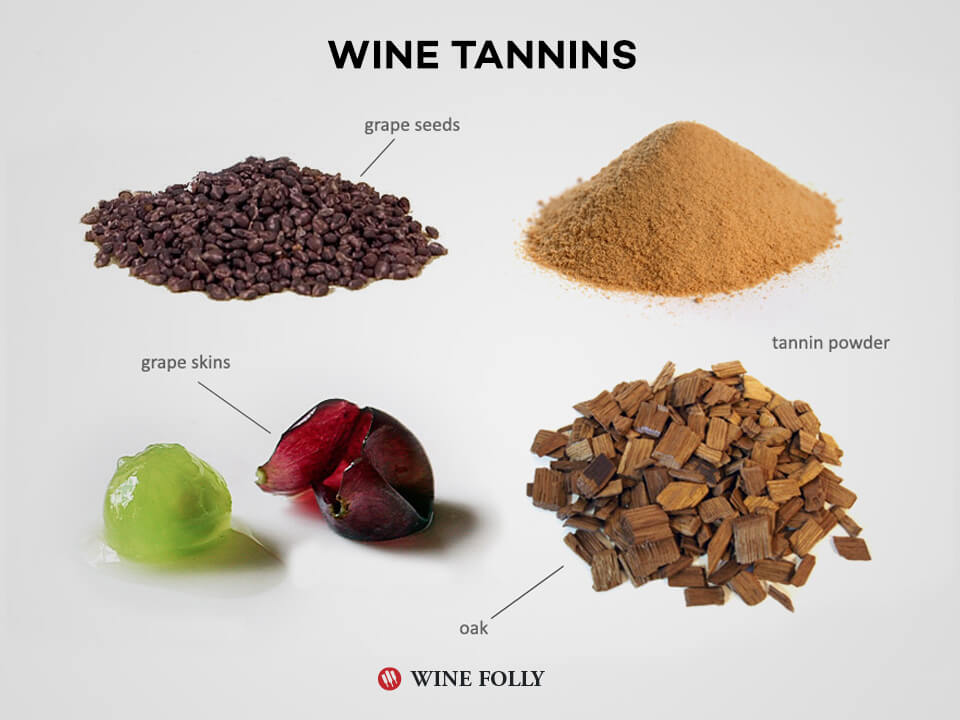When tasting red wine, you may have heard people speak about tannins and describing them as harsh, smooth, astringent and so on. If you are new to wine tasting, you also may not know exactly what these terms refer to…so let’s explain and take the mystery out of this very important component of wine!
Tannins defined
Tannins are important structural components call polyphenols and are mainly found in red wines. They have a bitter taste in wine. They help to stabilize the wine and protect it against oxidation (the often negative influence of exposure to oxygen). In humans, they also have health benefits, such as lowering cholesterol …maybe another reason to drink wine?
Tannins are not only just in wine; they are components of many plants, found in leaves, seeds and bark. If you drink tea, you have experienced tannins. Tannins are also found in the oak that is used to ferment or age wines.

Tannin Facts:
- The more unripe a grape was when picked, the more astringent or bitter the wine will be
- The younger a wine is, the higher the tannins.
- A bit of residual sugar in wine can make tannins see softer
- High acidity in wines can make tannins seem more astringent
- Tannins can be softened with winemaking techniques such as time in oak, length of ageing and maturation and the method of pressing the grapes
Tasting Tannins
Tannins bind with proteins in the mouth and cause your mouth to dry up and feel rough, creating a sensation that is quite particular. When I teach wine lovers about tannins, I usually say it feels like fur growing on your tongue. Sometimes they also have a bitter taste that lingers at the back of your mouth Depending on the level of tannin, the experience can be unpleasant or enhance the characteristics of the wine.
Talking About Tannins
Tannins can be ranked from 1 to 5, 1 being the least and 5 being the most.
A wine that is bitter with unripe tannins is called “astringent, whereas ripe tannins contribute more to textural richness. It takes experience to be able to conclude that a basic-quality
Descriptors along the scale:
- Unripe tannins: astringent, harsh, bitter, green, stalky, gritty or coarse in texture
- Ripe tannins: smooth, rich, velvety, soft, adding body, fine texture
Just because a wine has a little or a lot of tannins it does not mean they are always negative. Much depends on the kind of grape, the ripeness, and the winemaking process. Examples of different tannin structures:
- A Pinot Noir has medium-low tannins (2) with low astringency; some of the tannins may be from oak.
- A Cabernet Sauvignon made from just-ripe grapes has a medium level (4) of tannins, despite them being very astringent and harsh
- A very astringent wine like a Tannat that has distinct tannins that grip at the mouth (5)
- A high-quality Shiraz from a very warm region may have very high levels of velvet-textured ripe tannins (5) but not be astringent.
The next time you try a red wine, think about how you would describe the tannins. Is there a certain tannin profile or structure that you prefer? Can you tell anything about the winemaking process? It’s a lot of information to unpack, but as you keep noticing the difference, you’ll start to understand tannins in wine much betted. And hopefully enjoy them ore as well!
Want to learn more basic wine tasting skills and enhance your wine experience?
Click here for more information on my upcoming class, How to Taste Wine – Learn the Basics.



